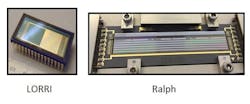e2v image sensors to capture first close-up images of Pluto and its moon
NASA's New Horizons Mission, which launched in January 2006, is hoping to capture the first-ever close-up images of Pluto and its moon Charon using two image sensors from imaging company e2v (Chelmsford, England). After traveling more than three billion miles to reach Pluto, it will provide scientific data about this little known region and the conditions at the origin of our solar system.
RELATED ARTICLE: Planetary and deep-space applications push spectroscopy to the outer limits
Matt Perkins, president of Space Imaging at e2v, said, "Very little is known about Pluto. It is classed as an icy dwarf, with a significant part of its mass believed to be made up of ice. It is so far away that even images from Hubble, which also uses e2v image sensors, are very blurred. Developing bespoke sensors for this mission is a great example of how we are bringing life to technology. We are extremely proud of our contribution and look forward to seeing what our sensors discover."
e2v has been involved in over 150 space projects, including the European Space Agency's Rosetta Mission, which successfully landed a probe onto comet 67p in November 2014. e2v has provided New Horizons with two specialist image sensors for the mission to Pluto--LORRI (Long Range Reconnaissance Imager) and Ralph.
LORRI is a black and white telescopic camera which has a 1k x 1k pixel image sensor at its core.
Paul Jerram, Chief Engineer of Image Sensors at e2v, said, "LORRI is very similar to the Navcam image sensor we made for the Rosetta mission, which has been producing the majority of the incredible images of comet 67p. LORRI will be providing images of the approach to Pluto, as well as high resolution geological data as New Horizons passes the dwarf-planet."
Ralph is a 5k wide multi-colour scanning imager which will produce a full color image of the surface of Pluto as New Horizons flies past. Paul Jerram continues, "Ralph is highly bespoke, in fact it is seven different CCDs (Coupled Charged Devices) made on the same substrate, providing a complete focal plane within a single sensor. As the spacecraft is travelling at 33,000 miles per hour and there is 1,000 times less sunlight at Pluto than at the Earth, this image sensor has to be extremely sensitive and has to work perfectly for the short time that the spacecraft is close to Pluto."
A major aspect of the delivery of e2v's image sensors into any space program is the testing required to ensure that they will survive the launch and operate to specification when needed. This involves environmental testing to show that the sensor performance will not be damaged by shock, vibration, temperature extremes and the radiation that is encountered outside the Earth's atmosphere. So while there is only a single sensor on-board the spacecraft, many sensors are produced and destructively tested to ensure that it will work as and when required.
New Horizons will be at its closest approach to Pluto at approximately 12:00pm (GMT) on 14 July 2015, and at this point e2v image sensors will have minutes to capture as much data as possible from the dwarf-planet as it flies by. Light or radio signals will take approximately 4.5 hours to get from Pluto back to Earth, therefore NASA hopes to release the first close-up images of Pluto at around 9:00pm (GMT) on 15 July 2015.
SOURCE: e2v; http://www.e2v.com/news/global-technology-company-e2v-is-set-to-capture-the-first-ever-close-up-images-of-pluto/
About the Author

Gail Overton
Senior Editor (2004-2020)
Gail has more than 30 years of engineering, marketing, product management, and editorial experience in the photonics and optical communications industry. Before joining the staff at Laser Focus World in 2004, she held many product management and product marketing roles in the fiber-optics industry, most notably at Hughes (El Segundo, CA), GTE Labs (Waltham, MA), Corning (Corning, NY), Photon Kinetics (Beaverton, OR), and Newport Corporation (Irvine, CA). During her marketing career, Gail published articles in WDM Solutions and Sensors magazine and traveled internationally to conduct product and sales training. Gail received her BS degree in physics, with an emphasis in optics, from San Diego State University in San Diego, CA in May 1986.
